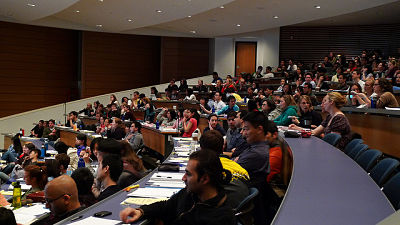As we approach the beginning of a new academic year, campus is abuzz with the return of students. Faculty are busy finishing syllabi, attending department retreats, and learning to fight for parking again. If you’re teaching a class this semester, it is important that you use the first day of class to set up a great semester. The first day is important for establishing norms and expectations. Don’t be one of those instructors that reads the syllabus and then dismisses class early.

The first day of class can help set you up for the rest of the semester. Specifically, I recommend you do the following five things to make sure you’re ready.
1. Arrive early and arrange the room as you want it. The physical layout of your classroom is important and immediately sends a message to your students. All my classes are discussion-based so I set up the room in a U shape. This lets the students know that we are going to be to be talking to each other and sets up a more informal tone. Obviously, you aren’t able to do this if you teach in a room with furniture that doesn’t move (something I avoid like the plague). Use the layout of your classroom to your advantage.
2. Check out your photo roster and learn names. If you have less than 40 students in class, you must make every effort to learn the names of your students as quickly as possible. On many campuses, you can get a photo roster of your class. Photo rosters are an invaluable resource to learn the names of some of your students before class even starts. Occasionally, the picture (often from their student ID) will be different, but for the most part it will give you an advantage. I also make notes on my roster to help me remember someone. I might simply make a note of what someone is wearing, how they pronounce their name, or where they are sitting. This provides a quick reference for me in class (and you should immediately use as many names as you can). These notes are also a resource for future classes when I need to refresh my memory.
3. Have students introduce themselves. Take the time to have students introduce themselves. I’ve never been a fan of those introduction icebreakers where you introduce yourself and say what animal you would be or what color you would be or any other strange thing. Instead, I have my students introduce themselves and also relevant aspects of their lives for the course. For example, in my higher education classes, I always have students tell where they work and where they went to undergrad as these are often significant aspects shaping their opinions. If I’m teaching a class on policy, I may also ask them to mention a major policy issue they think impacts higher education. At the end of the day, I want students to get to know each other better as it makes our discussions as a class better.
4. Set the tone. The first day of class sets the tone for the semester. Generally, the class should follow the format that you intend to follow throughout the semester. Are you going to lecture for a few minutes and have the students discuss ideas? Then do that on the first day. If you’re going to take a five minute bathroom break because you’re teaching a long class, do that on the first day. Are you going to expect the students to participate in class? Then do that the first day too. As much as possible, run the first day just as you would any class which will set the norms and expectations for the semester.
5. Activity to gauge students’ abilities. One of the most valuable exercises that I do on the first day is an activity to gauge the abilities of my students. As quickly as possible, I want to learn who are the stronger and weaker students. I also want to know who has experience with the content. Some students are quiet while some are talkative and I need to know this quickly too. All this information helps me in thinking about future class sessions. Sometimes these first impressions are wrong and that is okay, but I get a quick sense that I can use when dividing students into groups or leading class discussions. I often use a group activity (a staple of my teaching on a weekly basis) as an activity to start to learn about my students. In this activity, I care less about the specific outcome than my observations of the students during the process. During the activity, I have my eyes and ears open attempting to learn as much about my students as possible. It is particularly helpful to have had some students in class before because this reduces the number of students I need to make sure I’m observing. My goal is to get an initial impression of all my students. This way I can start thinking about how to best tailor future discussions and activities based on their experience, needs, and abilities.
By the end of my first class session, I have set the norms for the semester so students know what to expect. I’ve learned most of the names in the class and have an idea of their respective abilities. I know all this because I use the first day of class to set up a great semester. Don’t waste the first day just passing out the syllabus and doing a little bit of housekeeping. You can learn an incredible amount and help your students understand their role in the class. Taking advantage of these first day tips will help you have a better semester and your students learn more too.

